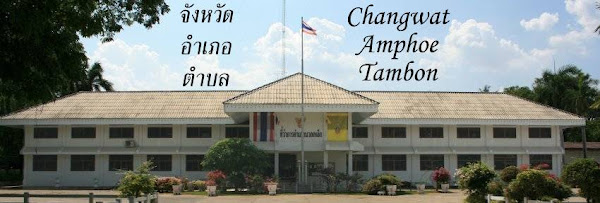Earlier today, the change of name of one administrative village in Nakhon Sawan was announced in the Royal Gazette. Mu 5 of Yang Tan subdistrict, Khok Phra district, was renamed from Ban Ta Nio (บ้านตานิว) to Ban Yang Tan (บ้านยางตาล). The name change was approved by the board to consider name changes in their meeting 1/2559 on April 29 - sadly no transcript or summary of these board meetings is available online.
Interestingly, in my XML I already had the new name, probably copied from the website of Yang Tan subdistrict administrative organization. Checking the other sources I used to compile my Muban list, it showed that the postcode list at noplink had the original name, and also back in 1997 when the subdistrict boundaries were defined officially that Muban was listed as Ban Ta Nio [Gazette].
Showing posts with label Nakhon Sawan. Show all posts
Showing posts with label Nakhon Sawan. Show all posts
Thursday, September 1, 2016
Thursday, June 23, 2016
New Muban in Nakhon Sawan
Somehow I almost missed the announcement of yet another new administrative village last week, this time in Nakhon Sawan province. The Muban became effective with the publication in the Royal Gazette on June 16.
- Mu 6 of Bueng Senat subdistrict, Mueang Nakhon Sawan district, Nakhon Sawan province, split from Mu 2 (Ban San Phing, บ้านสันพิง) and named Ban Khlong Krang (บ้านคลองกร่าง). [Gazette]
Friday, December 11, 2009
Nakhon Sawan municipality office
While adding the locations of the administrative entities into my XMLs in order to have the automatically created map as full as possible, flying to Nakhon Sawan with Google Earth to my surprised showed a 3d model of the municipality office.
As I wasn't in Nakhon Sawan yet, the only photo I can show here is one by the user Love Krittaya from Wikimedia Commons, showing the front facade. One can easily see the 3d model is quite close, even though its a bit simplified - the columns are done by a photo texture, not by actual 3d modeling.
As I wasn't in Nakhon Sawan yet, the only photo I can show here is one by the user Love Krittaya from Wikimedia Commons, showing the front facade. One can easily see the 3d model is quite close, even though its a bit simplified - the columns are done by a photo texture, not by actual 3d modeling.
Wednesday, October 1, 2008
Highest number of Muban ever?
While working through the older subdistrict creations, I have run across a case where the number of muban was by far higher than in all the cases I have found before. The subdistrict Tak Fa (ตากฟ้า) was created in 1961 containing just 5 muban. However just 6 years later, 4 new subdistricts were split off from Tak Fa, each containing 10 muban, and the villages 1 to 12 stayed with Tak Fa. Thus in these 6 years the number of villages increased to the tenfold (Announcement), altogether the subdistrict had 52 muban when it was split.
Amphoe.com has just a short history of the district Tak Fa.
Amphoe.com has just a short history of the district Tak Fa.
อำเภอตากฟ้า เดิม อยู่ในเขตการปกครองของอำเภอตาคลี จังหวัดนครสวรรค์ พื้นที่เป็นป่าดงดิบ มี สัตว์ป่าชุกชุมมาก พ.ศ. 2496 ทางราชการได้ตัดถนนพหลโยธินผ่าน โดยแยกออก จากอำเภอตาคลี โดยจัดตั้งเป็นกิ่งอำเภอตากฟ้า เมื่อวันที่ 13 ตุลาคม 2513Which translates to
District Tak Fa originally belonged to Takhli district, Nakhon Sawan province. It was an area covered with jungle and with plenty of wild animals. In 1953 the government build the Phahonyothin highway. Because of this the minor district Tak Fa was split off from Thakli on October 13 1970.In fact this is even not fully correct, as the district did not start as a minor district, but was created as a full district directly. The district then covered the area of the original subdistrict Tak Fa plus the subdistrict Udom Thanya which was also created in 1967 out of Hua Wai, altogether 6 subdistricts. Yet it does not give the full explanation of the rapid development of the area in the 1960s, as that main road was build several years before already. There must have been some more development programs, using the track of the highway as their starting point to convert the jungle into agricultural lands.
Subscribe to:
Posts (Atom)

